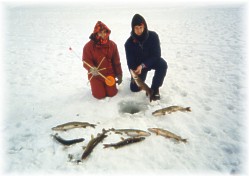Ice Fishing for Perch Cont.
As you can see, ice fishing for perch is a wonderful way to spend a winter
afternoon. By following through with these tactics and techniques, you'll be on your way
to becoming a successful perch fisherman, and will start to appreciate that winter is not
the end of the fishing season, and that putting the boat away, is just the beginning to a
new angling experience. Have a great ice season and be safe out there.
Justin Hoffman is a graduate of The North
American School of Outdoor Writing and also a member of the Outdoor Writers Assoc. of
America. He has been published in Ontario Out-Of-Doors, Canadian Sportfishing, and
Just Fishing Newspaper, and works for a number of internet sites. Justin is
available for freelance writing and photography assignments as well as lodge and product
reviews.
Ice Fishing Survival Tips by Laura Reave
If you ask experts when the ice is safe, they will often say, "Never!"
That is because ice thickness can vary by several inches even just a few feet away.
Variables include water current under the ice, schools of fish that can cause warmer water
to rise, vicinity to bridges and islands, and other factors.
Given that, many people have still enjoyed ice fishing for years. How can you
help ensure your survival while ice fishing? Here are a few basic tips:
1. Before you leave, tell someone where you are going and when you plan to
return. Survival experts suggest that if you are not back by that time, the person should
call for help.
2. Leave your car on shore. According to safety expert Tim Smalley, 68 percent
of ice fatalities in Minnesota involved a vehicle. Ice must be much thicker and more
stable to support the weight of a car or truck, or even a snowmobile.
3. Make sure there are at least 4 inches of clear, solid ice, with no open water
or melting ice near shore. Open water and melting indicate unsafe ice. Carry an ice spud
or chisel to check the thickness of the ice as you proceed.
4. Always go fishing with a companion. 5. Wear a lifejacket.
6. Carry two ice picks, hand spikes, or wooden screwdrivers tied together with
cord so that you can pull yourself out if you do fall in.
7. Carry rope to help drag your buddy out if necessary. 8. Carry a cell
phone to call for assistance.
9. Carry flares or an emergency signal marker so that you can be seen if you
need to be rescued in a storm. Other storm survival equipment includes chemical hand
warmers, flashlight and batteries, chemical light sticks, compass, reflective
"space" blankets, portable camp stove with fuel, pocket knife or pocket tool,
and matches or a lighter.
Laura Reave, Ph.D.,
is a marketing consultant specializing in writing for the internet and search engine
optimization. You can see some of her work at http://www.fcsurplus.ca
| "Remember that angling is an art, and an art worthy the knowledge and
practice of a wise man." Izaak Walton |
|